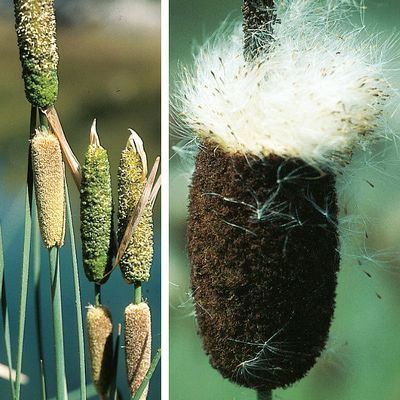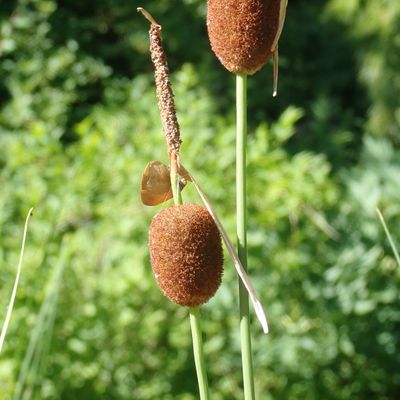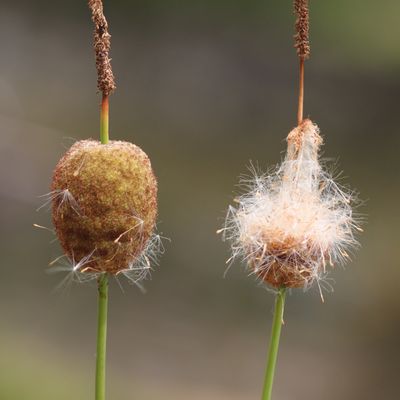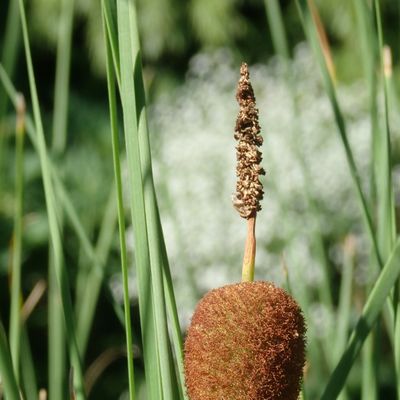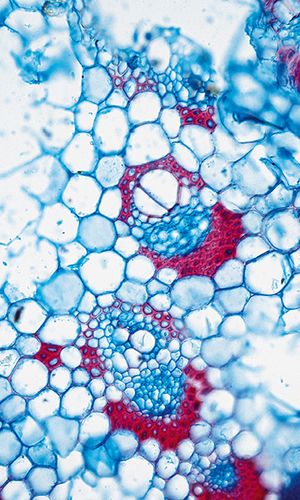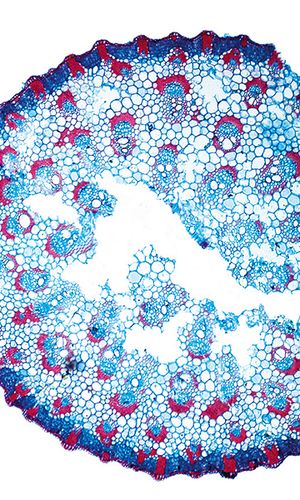Typha minima Hoppe
1048270
Species
ISFS : 432300
Checklist : 1048270
ISFS : 432300
Checklist : 1048270
Contains :
Synthesis
Species description (© Flora Helvetica 2018)
Blütentragende Stängel 30-80 cm hoch, nur mit Blattscheiden oder kleinen, den Blütenstand nicht überragenden Blattspreiten. Blätter graugrün, an den sterilen Trieben nur 1-3 mm breit. Männlicher und weiblicher Blütenstand +/- gleich lang, je 1,5-5 cm lang, dazwischen eine 0,5-3 cm lange Lücke. Fruchtstand kugelig oder eiförmig bis kurz zylindrisch.Flowering period (© Flora Helvetica 2018)
5Habitat and distribution inside Switzerland (© Flora Helvetica 2018)
Schlick an Flussufern, früher weit verbreitet entlang der Flüsse / kollin(-montan) / CH, zerstreutWorld distribution (© Flora Helvetica 2018)
EurasiatischEcological indicator (© Flora Helvetica 2018)
4fw+43-444.g.2n=30Status
IUCN status
Critically endangeredNational Priority
2 - high national priorityInternational responsibility
1 - weakConservation
Threats
Bau von Verkehrswegen
Grundwasser- und Flussbettabsenkungen
Sukzession
Konkurrenz (z. B. Calamagrostis epigeios falls Deckung > 10%)
Beschattung
Anatomy
Summary of stem anatomy (German)
Umriss rund oder oval. Leitbündel diffus verteilt. Konische Stützen. Epidermiszellen verholzt.Description
Culm-diameter 2-5 mm, center full, radius of culm in relation to wall thickness 1:1. Outline circular with a smooth surface. Outline circular, with rips. Culm-center full, containing unlignified cells. Epidermis smooth. Epidermis cells thin-walled all around. Chlorenchyma present, continuous peripheral belt with unlignified round cells (like a large cortex). Groups of sclerenchyma square or rectangular. Vascular bundles collateral closed. Sclerenchymatic sheath around vascular bundles one-sided large, 2-4 cells, centripetal. Vessel arrangement irregularly grouped or distributed. Crystals absent.Distribution map
Habitat and distribution inside Switzerland
CH, zerstreutWorld distribution
EurasiatischEcology
Life form
Geophyte
Habitats
Milieux Phytosuisse (© Prunier et al. 2017)
Habitats © Delarze & al. 2015
 | 2.2.3 - Kalkreiches Kleinseggenried (Davallseggenried) (Caricion davallianae) |
bold
Dominant species, influencing the appearance of the habitat
 Character species
Character species
 Less strictly linked to a specific habitat
Less strictly linked to a specific habitat
Ecological indicator values by © Landolt & al. (2010)
| Soil factors | Climatic factors | Salinity tolerance | |||
|---|---|---|---|---|---|
| Humidity Value H | 4fw+ | Light Value L | 4 | Salinity Index | -- |
| Reaction Value R | 4 | Temperature factor T | 4 | ||
| Nutriments value N | 3 | Continentality K | 4 | ||
- Ecological values legend
Humidity Value H 1 very dry 1+ dry 2 moderatly dry 2+ moist 3 medium wet 3+ wet 4 very wet 4+ soggy 5 submerged or underwater f plants living in running water u mostly submerged plants v partly submerged, partly floating plants w humidity moderately variable (± scale of 1-2) w+ highly variable humidity (scale exceeding ± 2) Reaction Value R 1 Very acid (pH 2.5-5.5) 2 acid (pH 3.5-6.5) 3 lightly acid to neutral (pH 4.5-7.5) 4 neutral to basic (pH 5.5-8.5) 5 basic (pH 6-5 -> 8.5 Nutriments value N 1 very low in nutrients 2 low in nutriments 3 medium-poor to medium-rich in nutrients 4 rich in nutriments 5 very rich in nutriments Salinity tolerance 1 halotolerant 3 halophyle Light Value L 1 very shady 2 shady 3 lighted areas 4 luminous 5 highly luminous Temperature factor T 1 alpine to nival stages (from the treeline to the snowline) 1+ suprasubalpine and upper subalpine levels (pine and larch forests) 2 subalpine level (coniferous forests without beeches up to the upper limit of spruces) 2+ lower subalpine and upper mountain stages 3 mountain level (beech and silver fir forests, in the central Alps Scots pine forests) 3+ lower mountain and upper hill levels 4 hill level (mixed deciduous oak forests) 4+ hot places, hill level 5 very hot places, hill level (only in the hottest places, typical of southern Europe) Continentality K 1 Atlantic (high air humidity, very low temperature variations, mild winters) 2 Sub-Atlantic (high air humidity, low temperature variations, relatively mild winters) 3 sub-Atlantic to subcontinental (average air humidity, moderately variable temperature, slightly low winter temperatures) 4 subcontinental (low air humidity, large temperature variations, rather cold winters) 5 continental (very low air humidity, very large temperature variations, cold winters)
Water dependency
| Rivers | 1 - Secondary habitat |
| Calm water | 0 - No link |
| Ground water | 0 - No link |
Nomenclature
Accepted Name (Checklist 2017)
Typha minima Hoppe
Vernacular name
Deutscher Name :
Zwerg-Rohrkolben, Kleiner RohrkolbenNom français :
Petite massetteNome italiano :
Lisca minoreMatch with other reference books
| Relation | Nom | Book | No |
|---|---|---|---|
| = | Typha minima Hoppe | Checklist 2017 | 432300 |
| = | Typha minima Hoppe | Flora Helvetica 2001 | 2830 |
| = | Typha minima Hoppe | Flora Helvetica 2012 | 2599 |
| = | Typha minima Hoppe | Flora Helvetica 2018 | 2599 |
| = | Typha minima Hoppe | Index synonymique 1996 | 432300 |
| = | Typha minima Hoppe | Landolt 1977 | 109 |
| = | Typha minima Hoppe | Landolt 1991 | 100 |
| = | Typha minima Hoppe | SISF/ISFS 2 | 432300 |
| = | Typha minima Hoppe | Welten & Sutter 1982 | 2381 |
= The taxon corresponds to the accepted taxon (Checklist 2017)
< The taxon is included in the accepted taxon (Checklist 2017)
> The taxon includes (among others) also the accepted taxon (Checklist 2017)
< The taxon is included in the accepted taxon (Checklist 2017)
> The taxon includes (among others) also the accepted taxon (Checklist 2017)
Status
Native status
-IUCN list of endangered species (© Walter & Gillett 1997) : No
Status on national Red List 2016
IUCN status:
Critically endangered

Additional information
IUCN criteria: A3c
Status on regional Red List 2019
| Biogregraphic regions | Status | IUCN criteria |
|---|---|---|
| Jura (JU) | RE | |
| Mittelland (MP) | CR | A3c |
| Alpennordflanke (NA) | CR | A3c |
| Alpensüdflanke (SA) | RE | |
| Östliche Zentralalpen (EA) | CR | A3c |
| Westliche Zentralalpen (WA) | CR | A3c |
- Legend
EX Extinct RE Regionally Extinct CR(PE) Critically Endangered, Probably Extinct CR Critically Endangered EN Endangered VU Vulnerable NT Near Threatened LC Least Concern DD Data Deficient NE Not Evaluated NA Not Applicable
National Priority Species List Status
| National Priority | 2 - high national priority |
| Need to take action | 2 - |
| International responsibility | 1 - weak |
| Need to monitor populations | 2 - |
Protection status
| International (Bern Convention) | Yes | |
| AG | total protection | (01.01.2010) |
| BE | total protection | (01.01.2016) |
| FR | total protection | (12.03.1973) |
| GE | total protection | (25.07.2007) |
| GL | total protection | (07.05.2006) |
| GR | total protection | (01.12.2012) |
| OW | total protection | (01.04.2013) |
| Switzerland | total protection | |
| SH | total protection | (06.03.1979) |
| SZ | total protection | (24.09.1992) |
| TG | total protection | (01.01.2018) |
| VD | total protection | (02.03.2005) |
| ZG | total protection | (01.10.2013) |
| ZH | total protection | (03.12.1964) |
| SG | total protection | (01.10.2017) |
- Disclaimer
InfoFlora compiles information on protected species as accurately as possible, taking it from the respective cantonal laws. In some cases, however, it was not possible to use the plant names as listed in the original text, but an interpretation of their taxonomy or nomenclature was necessary. The exact meaning of the categories „completely protected“ and „partially protected“ differs among the cantons.
InfoFlora cannot guarantee that the information on the protection status is correct and complete. In case of doubts, we recommend to look up the texts of the respective cantonal law.
Status by sector of activity
| Agriculture-related environmental objectives : | more informations | |
| Forest management environmental objectives : | more informations |
Conservation
Threats and measures
Bau von Verkehrswegen
Anpassen problematischer Bauprojekte
Grundwasser- und Flussbettabsenkungen
Verhinderung der Grundwasserabsenkungen
Sukzession
Natürliche Flussdynamik erhalten, sonst künstlich geeignete Pionierlebensräume schaffen. Dynamik und Freiflächen durch neue Sandschüttungen schaffen
Konkurrenz (z. B. Calamagrostis epigeios falls Deckung > 10%)
Reduzieren der Konkurrenten falls notwendig
Beschattung
Ausholzen der beschattenden Büsche und Bäume
